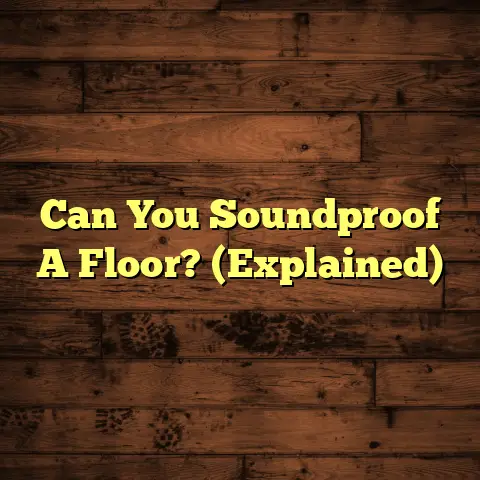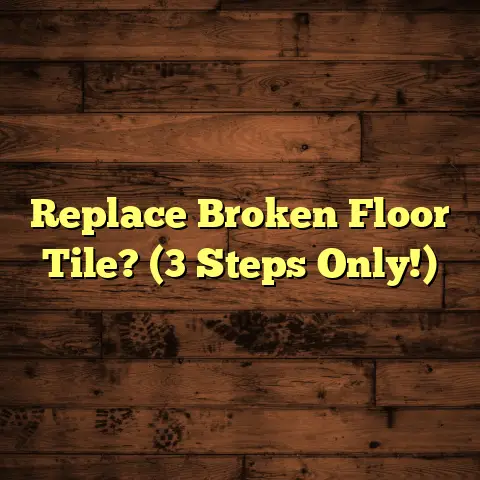Why Are Floors Cold? (7 Contractor Fixes!)
Ever stepped out of bed on a freezing winter morning, and your bare feet hit an icy floor?
That instant shiver that shoots right up your spine? Yeah, I know that feeling.
It’s like the cold just seeps into your bones, and all you want to do is dive back under the covers.
And it’s not just a morning thing, is it? Cold floors can ruin family gatherings, make cozy evenings feel… well, not so cozy, and generally make your home feel less inviting.
Believe me, you’re not alone in this battle against the chill. As a flooring contractor with years of experience, I’ve seen (and felt!) it all.
Let’s dive into why your floors are so darn cold, and more importantly, what we can do about it!
Section 1: Understanding the Causes of Cold Floors
So, what’s making your floors feel like an ice rink? It’s usually a combination of factors. Let’s break them down:
1.1. Insulation Issues
Think of insulation as a cozy blanket for your house. Without enough of it, especially in basements and crawl spaces, cold air can easily sneak in and make your floors frigid.
It’s all about heat transfer. Heat naturally moves from warmer areas to colder ones. When your insulation is lacking, the warmth from your living space escapes downwards, and the cold from below creeps upwards.
According to the U.S. Department of Energy, homes without proper insulation can lose a significant amount of heat through the floors.
I’ve personally seen homes where simply adding insulation in the crawl space made a huge difference in floor temperature. It’s often the most cost-effective first step.
1.2. Type of Flooring Material
Did you know your choice of flooring plays a big role in how cold your floors feel? It’s true!
Some materials are naturally colder than others. Think about it: ceramic tile vs. a plush carpet.
- Ceramic tile: Looks great, durable, but notorious for feeling cold underfoot. It doesn’t retain heat well.
- Hardwood: Can feel cooler than carpet, but it’s not as bad as tile. It can hold some heat.
- Laminate: Similar to hardwood in terms of temperature.
- Carpet: The warmest option, as it traps air and provides insulation.
Here’s a quick comparison:
| Flooring Material | Thermal Conductivity (Lower is better) |
|---|---|
| Concrete | 1.28 W/mK |
| Ceramic Tile | 1.05 W/mK |
| Hardwood | 0.16 W/mK |
| Carpet | 0.04-0.06 W/mK |
(Note: Thermal conductivity measures how well a material conducts heat. Lower values mean better insulation.)
1.3. Climate and Environment
Where you live has a massive impact on how cold your floors get. Makes sense, right?
If you’re in a place with harsh winters, like Minnesota or Maine, you’re going to struggle more with cold floors than someone in sunny California or Florida.
Homes in colder climates need extra attention to insulation and heating to combat the frigid temperatures.
I’ve worked on homes in the mountains where the floors felt like ice year-round! In those cases, we had to pull out all the stops: insulation, radiant heating, and warmer flooring choices.
1.4. HVAC System Inefficiencies
Your HVAC (Heating, Ventilation, and Air Conditioning) system is supposed to keep your whole house comfortable, but sometimes it falls short.
If your system isn’t properly sized for your home, or if the ductwork is poorly designed or leaky, you might end up with uneven heating.
This often results in cold floors because the warm air isn’t reaching the lower levels of your home effectively.
I once diagnosed a house with chronically cold floors only to discover that the ductwork in the basement had several gaping holes! Warm air was escaping before it could even reach the upstairs.
1.5. Home Age and Structure
Older homes often have design flaws or outdated materials that contribute to cold floors.
They might lack proper insulation, have single-pane windows, or have cracks and gaps that let in cold air.
Building codes and construction practices have improved over time, so newer homes are generally better insulated and more energy-efficient.
However, even newer homes can have issues if they weren’t built properly or if the insulation has settled or deteriorated over time.
Section 2: The Emotional Toll of Cold Floors
Okay, so cold floors are uncomfortable. We get that. But it goes deeper than just physical discomfort. It can actually impact your life in some surprising ways.
2.1. Impact on Family Life
Think about it: are you constantly arguing with family members about the thermostat? Do your kids complain about playing on the floor?
Cold floors can create tension and make it harder to enjoy time together as a family.
I’ve seen families where the kids refuse to play in the living room because the floor is too cold, or where the elderly grandparents avoid visiting because they can’t handle the chill.
2.2. Mental Well-being
A cold environment can lead to feelings of discomfort, unease, and even stress.
It can affect your mood, your productivity, and your overall sense of well-being.
Studies have shown that people are more likely to feel irritable and less focused in cold environments.
Your home should be a sanctuary, a place where you can relax and recharge. Cold floors can undermine that feeling of comfort and security.
2.3. Safety Concerns
Cold floors can also be slippery, especially if they’re tile or hardwood. This can be a safety hazard, particularly for the elderly and small children.
Falls are a leading cause of injury, and slippery floors are a major culprit.
The anxiety of worrying about someone slipping and falling can add to the stress of living with cold floors.
Section 3: Seven Contractor Fixes for Cold Floors
Alright, enough about the problems. Let’s talk solutions! Here are seven contractor-approved fixes for cold floors:
3.1. Improve Insulation
This is often the first and most important step. We can add insulation to your floors, basement, and crawl space to create a barrier against the cold.
There are several types of insulation we can use, including:
- Fiberglass batts: A common and affordable option.
- Spray foam: Provides excellent insulation and seals gaps and cracks.
- Rigid foam boards: Ideal for insulating basement walls.
The best type of insulation for your home will depend on your specific needs and budget. I always recommend getting a professional assessment to determine the right approach.
3.2. Install Radiant Floor Heating
This is where things get really warm and cozy. Radiant floor heating systems heat your home from the ground up, providing consistent and comfortable warmth.
There are two main types of radiant floor heating:
- Electric: Uses electric cables or mats embedded in the floor.
- Hydronic: Uses hot water circulating through pipes under the floor.
Radiant floor heating is more expensive to install than other heating systems, but it can be more energy-efficient in the long run and provide a level of comfort you won’t believe.
I installed radiant heating in my own bathroom a few years ago, and I’ll never go back. Stepping onto a warm tile floor on a cold morning is pure bliss!
3.3. Upgrade Your HVAC System
If your HVAC system is old, inefficient, or undersized, it might be time for an upgrade.
A new, properly sized system can distribute heat more evenly throughout your home, eliminating cold spots and keeping your floors warmer.
We can also assess your ductwork to identify and seal any leaks, ensuring that warm air is reaching all the right places.
3.4. Choose Warmer Flooring Options
If you’re renovating or replacing your floors, consider choosing materials that retain heat better.
- Carpet: As we discussed earlier, carpet is the warmest option.
- Cork: A naturally warm and comfortable material.
- Vinyl: Some types of vinyl flooring are designed to be warmer than others.
Even if you’re not ready for a full-scale renovation, adding rugs and mats can make a big difference.
3.5. Seal Gaps and Cracks
Drafts can make your floors feel much colder than they actually are. We can identify and seal gaps around windows, doors, and floors to prevent cold air from entering your home.
Caulking and weather stripping are your friends here. It’s a relatively inexpensive fix that can have a big impact.
3.6. Add Rugs and Mats
This is the simplest and most immediate solution. Rugs and mats provide a layer of insulation between your feet and the cold floor.
Choose thick, plush rugs for maximum warmth. And don’t forget to add mats in high-traffic areas like entryways and bathrooms.
3.7. Create a Barrier with Landscaping
Believe it or not, your landscaping can actually impact the temperature of your home.
Planting trees and shrubs around your home can block cold winds and provide shade in the summer, helping to regulate the temperature and keep your floors warmer in the winter.
Deciduous trees are a great option because they provide shade in the summer and allow sunlight to penetrate in the winter.
Conclusion: Call to Action
So, there you have it: seven proven ways to combat cold floors and create a warmer, more comfortable home.
Don’t let cold floors ruin your comfort and happiness. Take action today!
Assess your own flooring situation, explore potential fixes with a qualified contractor (like me!), and envision your ideal warm home, where cold floors are a thing of the past.
A warm, inviting home is not just a luxury, but a necessity for your comfort and well-being. Every step you take towards warmer floors is a step towards a happier, healthier you. Now go get those feet warm!





